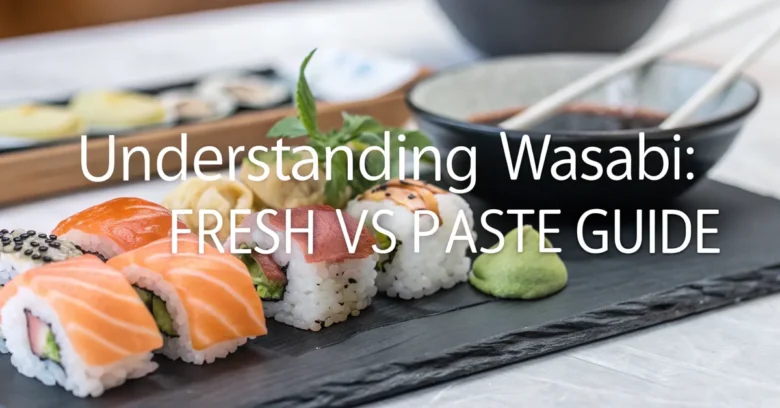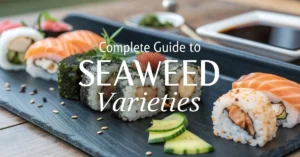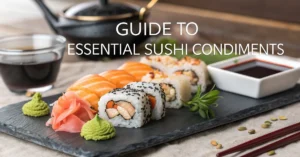Wasabi, that vibrant green paste served alongside sushi, packs a distinctive punch. But how much do you really know about what you’re eating? Many sushi lovers may not realize the difference between fresh wasabi and the more common paste. The quest for real wasabi is a journey into the heart of authentic Japanese cuisine.
In this guide, you’ll learn the nuances of real wasabi versus the imitation stuff. We will look at its flavor profile, health benefits, and where to find it, this article will help you elevate your sushi experience. So, ditch the impostor and discover the world of real wasabi.
Understanding Wasabi: Fresh vs Paste Guide
Wasabi, often dubbed “Japanese horseradish,” is a vital part of sushi culture. Its fiery kick and unique flavor make it a key condiment. However, the wasabi most of us know is often a far cry from the real deal. This guide will explore real wasabi, how it differs from the paste, and why it matters to sushi enthusiasts like you.
What is Real Wasabi?
Real wasabi (Wasabia japonica, Eutrema japonicum) is a plant native to Japan. It grows in cool, mountain stream beds. The rhizome, or underground stem, is what we know as wasabi. It is prized for its distinct taste and texture.
Fresh wasabi has a complex flavor that goes beyond simple heat. The initial punch gives way to a sweet, grassy taste. It has a clean finish that enhances, rather than overpowers, the flavors of the fish.
What is Wasabi Paste Made Of?
Most wasabi paste isn’t real wasabi at all. Due to the high cost and limited availability of the real plant, imposters are common.
The typical wasabi paste contains:
- Horseradish: This is the main ingredient, providing the spicy base.
- Mustard Flour: This adds extra heat and a pungent aroma.
- Green Food Coloring: This gives the paste its signature green hue.
- Other Additives: These may include fillers, preservatives, and flavor enhancers.
While this paste does offer a spicy kick, it lacks the nuanced flavor and fresh aroma of real wasabi.
The Key Differences Between Real Wasabi and Wasabi Paste
Knowing the differences between real and fake wasabi can greatly enhance your culinary appreciation.
Flavor Profile
- Real Wasabi: Starts with a sharp, clean heat that quickly fades, leaving a sweet, green, and herbal aftertaste. The flavor is complex and aromatic, complementing the flavors of sushi.
- Wasabi Paste: Delivers a harsh, often one-dimensional heat that can linger unpleasantly. It lacks the sweetness and complexity of real wasabi, often overpowering the delicate taste of the fish.
Texture
- Real Wasabi: Has a slightly grainy texture from being freshly grated. This adds to the sensory experience.
- Wasabi Paste: Usually has a smooth, uniform texture. This can feel artificial compared to freshly grated wasabi.
Aroma
- Real Wasabi: Offers a fresh, vibrant aroma that stimulates the senses. The scent is clean and slightly floral, enhancing the overall experience.
- Wasabi Paste: Often has a less appealing, somewhat chemical smell due to the artificial ingredients and preservatives used.
Color
- Real Wasabi: Features a natural, pale green color. The shade is subtle and reflects its natural origin.
- Wasabi Paste: Typically has a bright, artificial green color, thanks to the added food coloring.
Ingredients
- Real Wasabi: Pure, unadulterated rhizome of the Wasabia japonica plant.
- Wasabi Paste: A mix of horseradish, mustard, coloring, and other additives. This lacks the natural purity.
Cost and Availability
- Real Wasabi: Expensive and difficult to find outside of Japan. Fresh wasabi is perishable and requires special growing conditions, driving up the price.
- Wasabi Paste: Cheap and widely available in supermarkets and restaurants. Its affordability and long shelf life make it a common substitute.
Why Choose Real Wasabi?
Opting for real wasabi offers several benefits that enhance your dining experience.
Authentic Flavor
Real wasabi provides an authentic taste that elevates sushi. It is meant to enhance rather than mask the flavor of fresh fish. The unique flavor profile makes it an essential part of traditional sushi appreciation.
Health Benefits
Real wasabi boasts several health benefits, thanks to its natural compounds.
- Antimicrobial Properties: Wasabi contains isothiocyanates (ITCs) that combat bacteria and fungi.
- Anti-Inflammatory Effects: ITCs can reduce inflammation in the body.
- Cancer Prevention: Studies suggest ITCs may inhibit cancer cell growth.
- Cardiovascular Health: Wasabi may improve blood flow and reduce the risk of blood clots.
These health benefits are less prominent in wasabi paste due to the lack of real wasabi.
Enhanced Culinary Experience
Freshly grated wasabi is a sensory delight. The aroma, texture, and complex flavor all add to the experience. This enhances the overall enjoyment of your sushi. Using real wasabi shows an appreciation for the artistry and tradition of Japanese cuisine.
Where to Find Real Wasabi
Finding real wasabi can be a challenge, but it’s worth the effort.
Specialty Japanese Markets
Your best bet is to check specialty Japanese markets. These stores often carry fresh wasabi rhizomes or freshly grated wasabi. Staff can help you select the best product and offer storage advice.
High-End Sushi Restaurants
Some high-end sushi restaurants use real wasabi. Don’t hesitate to ask if they use real wasabi before ordering. Establishments that value authenticity will proudly offer it.
Online Suppliers
Several online suppliers specialize in importing real wasabi. Be sure to check reviews and ensure they source their wasabi sustainably.
Growing Your Own
For the dedicated foodie, growing your own wasabi can be a rewarding experience. Wasabi requires specific conditions to thrive. This includes shade, consistent moisture, and cool temperatures. Sourcing seeds or seedlings from a reputable supplier is crucial for success.
How to Identify Real Wasabi
Identifying real wasabi requires careful observation and knowledge.
Check the Ingredients
Always read the ingredient list. Real wasabi should only list “wasabi” or “Wasabia japonica.” Avoid products with horseradish, mustard, or artificial coloring.
Look for Freshness
Fresh wasabi rhizomes should be firm and vibrant green. Avoid any that appear dry, shriveled, or discolored.
Ask Questions
If purchasing from a restaurant or market, ask about the wasabi’s origin. Authentic establishments will be transparent about their sources.
Taste Test
Real wasabi has a unique flavor profile. It starts with a sharp heat but quickly mellows into a sweet, green flavor. Imitation wasabi tends to be harsh and lacks complexity.
How to Grate and Serve Real Wasabi
Proper grating and serving are key to enjoying real wasabi.
Tools Needed
- Wasabi Grater: A traditional wasabi grater uses sharkskin to create a fine paste. Ceramic graters with fine teeth are also effective.
- Fresh Wasabi Rhizome: Choose a firm, green rhizome.
- Small Dish: For serving the grated wasabi.
Grating Process
- Wash and Dry: Gently wash the wasabi rhizome and pat it dry.
- Prepare the Grater: Ensure your wasabi grater is clean and dry.
- Grate in Circular Motions: Hold the rhizome at an angle and grate in small, circular motions. Apply gentle pressure to release the flavors.
- Grate Only What You Need: Wasabi loses its flavor quickly after grating. Only grate what you plan to use immediately.
Serving Suggestions
- Small Portions: Serve wasabi in small portions. A pea-sized amount is usually sufficient.
- Placement: Place the wasabi directly on the fish, not mixed into the soy sauce. This allows you to control the flavor and enjoy the pure taste of the wasabi.
- Enjoy Immediately: Grated wasabi is best enjoyed within 15 minutes. The flavor degrades quickly as it oxidizes.
Storing Real Wasabi
Proper storage extends the life of your real wasabi.
Fresh Rhizome Storage
- Wrap in Damp Paper Towel: Wrap the wasabi rhizome in a damp paper towel.
- Place in a Plastic Bag: Put the wrapped rhizome in a plastic bag and seal it tightly.
- Refrigerate: Store in the refrigerator for up to a week. Change the paper towel every couple of days to maintain moisture.
Grated Wasabi Storage
- Consume Immediately: Grated wasabi is best consumed immediately.
- Short-Term Storage: If you must store grated wasabi, cover it tightly in plastic wrap and refrigerate. Use it within a few hours for the best flavor.
Pairing Wasabi with Different Types of Sushi
Wasabi enhances different types of sushi in unique ways.
Nigiri
- Tuna (Maguro): Wasabi complements the rich, buttery flavor of tuna.
- Salmon (Sake): Balances the oiliness of salmon with its spicy kick.
- Yellowtail (Hamachi): Enhances the clean, slightly sweet taste of yellowtail.
Sashimi
- Scallop (Hotate): Highlights the delicate sweetness of scallop.
- Sea Urchin (Uni): Cuts through the richness of sea urchin with a spicy contrast.
- Octopus (Tako): Tenderizes the texture of octopus and adds a burst of flavor.
Rolls
- California Roll: Adds a spicy kick to the mild flavors of avocado, crab, and cucumber.
- Spicy Tuna Roll: Intensifies the heat and complements the tuna.
- Vegetable Rolls: Enhances the freshness of vegetables with a zesty bite.
Common Myths About Wasabi
Several myths surround wasabi, leading to misconceptions.
Myth: All Sushi Restaurants Use Real Wasabi
Reality: Most sushi restaurants use wasabi paste due to its cost-effectiveness.
Myth: Wasabi’s Heat Comes From Capsaicin
Reality: Wasabi’s heat comes from isothiocyanates, which provide a different type of heat than capsaicin in chili peppers.
Myth: Wasabi Should Be Mixed Into Soy Sauce
Reality: Mixing wasabi into soy sauce dulls its flavor and changes the texture of the soy sauce. It is best placed directly on the fish.
Myth: The More Wasabi, The Better
Reality: Too much wasabi can overpower the flavors of the sushi. A small amount is usually sufficient.
The Future of Wasabi: Sustainability and Innovation
The future of wasabi involves sustainable practices and innovative products.
Sustainable Farming
Efforts are underway to develop sustainable wasabi farming methods. This helps protect natural habitats and ensures a stable supply of real wasabi.
Vertical Farming
Vertical farming offers a controlled environment for growing wasabi. This minimizes environmental impact and maximizes yield.
Wasabi-Infused Products
Innovative products like wasabi-infused snacks, sauces, and condiments are emerging. This broadens the appeal of wasabi beyond traditional sushi.
Educating Consumers
Educating consumers about the differences between real and fake wasabi is key. This empowers them to make informed choices and appreciate authentic flavors.
Should You Get Real Wasabi?
If you value authentic flavors and want to elevate your sushi experience, then getting real wasabi is worth the effort. While it may be more expensive and harder to find, the unique taste, health benefits, and cultural significance make it a worthwhile addition to your culinary adventures. So, next time you enjoy sushi, consider seeking out real wasabi for a truly authentic and enhanced dining experience.



